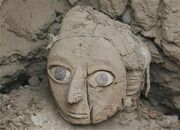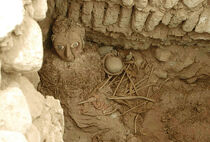No edit summary Tag: Source edit |
(Adding categories) |
||
| Line 44: | Line 44: | ||
http://www.reuters.com/article/us-peru-archaeology-idUSN2636587520080826<br> |
http://www.reuters.com/article/us-peru-archaeology-idUSN2636587520080826<br> |
||
| + | [[Category:Natural Mummy]] |
||
Revision as of 15:59, 31 March 2021
The Lady of the Mask is thought to be a member of the Wari people, an indigenous civilization that flourished in the south central Andes in modern day Peru from abut AD 500 to 1000. Unfortunately, these people never developed a written language and left no inscriptions that would provide clues to their customs or beliefs. Found by archaeologists excavating a pyramid in Lima, the mummy was alongside two other adult mummies and the sacrificial remains of a child. Archaeologists found items associated with weaving and concluded that she may have been "the Chief of the Weavers" or of "a guild that made textiles."
Mummification
Because any mummification was natural rather than intentional, he bodies inside burial bundles might be only bones or partially dried-out bodies.
Studies
She is assumed to be a noblewoman because of the ornate mask and was found in a crouching position surrounded by ceramics and textiles associated with female weavers.

It is the first intact Wari burial site discovered at Huaca Pucllana, and researchers believe it dates from about AD 700.
Wrapped in six layers of cotton and llama-wool textiles. She wore a wooden mask with a feminine face and large blue eyes made of seashells--earning her the nickname la Dama de la Máscara (the Mask Lady). The team also excavated gourds, kitchen vessels, textiles, and other objects.
Scientists believe that ancient Wari people commonly sacrificed young children, in particularly females, as a part of the burial traditions.
Additional
The Wari came from Peru’s southern highlands and ruled a vast area of the country from AD 500 to 1000, they conducted multiple burials and buried them with provisions and the tools of their trade.
It is evident that Wari culture pre-dates that of Incan civilization, and there is no evidence that suggests these people had a written language. As a result, there is no textual evidence that provide insight into the customs and beliefs of the Wari people.
This particular discovery served a great purpose as it helped to uncover how Wari people conducted burials. It is one of the select sites that had the mummy and the contents of the burial mound fully intact as previously discovered sites tended to have their contents fairly damaged.
References
http://archive.archaeology.org/0901/topten/masked_mummy.html
http://www.messagetoeagle.com/lady-mask-wari-mummy-faked-blue-eyes-face-dont-forget-easily/
http://www.reuters.com/article/us-peru-archaeology-idUSN2636587520080826
